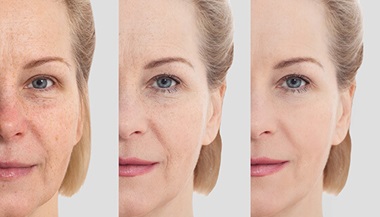Is a Liquid Face-Lift Right for You?
Featured Expert:
According to Lisa Ishii, M.D., a specialist at the Johns Hopkins Center for Facial Plastic and Reconstructive Surgery, what many women see in the mirror as they age doesn’t reflect how they feel inside. It’s one of the main reasons women turn to anti-aging procedures, such as injections and face-lifts.
Aging breaks down connective fibers, such as collagen and elastin, and also causes a loss of fat in deep layers of the skin. The result is sagging, loose skin that wrinkles more easily. While many women want to fight back against this process, not everyone feels comfortable having surgery to look younger.
Luckily, there is a nonsurgical option called a liquid face-lift. Ishii discusses the benefits and drawbacks of the liquid face-lift for facial rejuvenation.
What is a liquid face-lift?
During a liquid face-lift, the patient receives multiple injections of dermal fillers, which are substances that restore facial fullness for a more youthful appearance. “The end goal is to plump up the skin,” says Ishii. “The beauty of this procedure is you can often get it done in one session.”
Before starting, your doctor will provide a local anesthetic to numb the area. Each injection takes just a few minutes and may target areas such as:
- The temples
- Underneath the lower eyelid
- Sagging cheeks
- Nasolabial folds between the nose and mouth, also called marionette lines
- Creases beside the mouth that cause jowls
The cost of the procedure varies based on the amount of filler the surgeon uses and where you live. “Pricing in New York City differs from pricing in Baltimore,” says Ishii.
Types of Dermal Fillers
Today, you have a range of injections to choose from when receiving a liquid face-lift. Fillers don’t last forever, so you must receive repeat injections to maintain results.
Popular fillers include:
- Hyaluronic acid: This is the most common class of fillers used. The effects last roughly eight months and are completely reversible — doctors can inject a substance to break up the hyaluronic acid if you don’t like the result.
- Calcium hydroxyapatite: These nonreversible fillers take longer to break down, lasting from 12 to 16 months.
- Poly-L-lactic acid: This type of filler stimulates collagen production and lasts up to 24 months. The effects appear gradually, requiring three to four injections over a series of visits.
- Collagen or fat: Also called soft tissue augmentation, collagen and fat injectable fillers are a temporary treatment for correcting wrinkles and scars. This category of fillers includes fat transfer from the patient’s own body. Soft tissue augmentation treatments last from three to 12 months.
Promising new treatments include platelet-rich plasma, a treatment that uses the patient’s own tissue. The specialist draws blood from the patient, spinning it down in a lab to separate plasma from blood cells. The doctor then injects that plasma back into the patient’s face. The plasma contains platelets and growth factors that may stimulate collagen production, although this link is not proven.
“The disadvantage is that it’s less predictable in terms of longevity,” says Ishii. “We don’t know if it lasts six months or six years.”
Risks and Drawbacks
While the side effects aren’t as severe as with a surgical face-lift, a liquid face-lift still causes some bruising. “Most people get very little bruising when you inject along the jawline, in the nasolabial folds or even in the cheeks,” Ishii says. “Most will get significant bruising for several days with injections underneath the eyes.”
Many women choose fillers because they offer faster recovery, fewer potential complications and a more attractive price tag than surgery. “In the short term, it’s going to be a little less expensive,” says Ishii, noting that it’s not a replacement for a surgical procedure.
Face-lift surgery requires 10 to 14 days of recovery, but the effects last as long as 10 years. And though dermal fillers can be more effective on areas such as the temples, the results aren’t comparable to surgery for other areas, such as:
- Jowls that form on the jawline
- Loose skin around the neck
- Nasolabial folds
- Drooping of midface tissue
- Double chin
Ultimately, a woman should carefully compare the risks and benefits of cosmetic plastic surgery versus injections with her doctor. If you’re looking for a noticeable lift but don’t want surgery, a liquid face-lift could be a good option.






